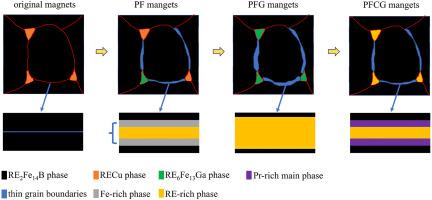Ce磁体晶界优化和磁性能的双重增强机制:Ga/Cu在PrFe基合金(PrFe, PrFeGa, prfeecuga)中的关键作用
IF 4.8
2区 材料科学
Q2 CHEMISTRY, PHYSICAL
引用次数: 0
摘要
为了抵消Ce元素对钕铁硼磁体磁性能的不利影响,本研究利用低熔点prfe基合金的晶界添加技术,成功制造出具有剩余力和矫顽力双重增强的磁体。实验结果表明,PFG (PrFeGa)磁体的矫顽力由原磁体的11.45 kg增加到14.25 kg,剩磁略有改善,而PFCG(PrFeGa)磁体的剩磁增加了0.52 kg,矫顽力增强了2.49 kg。prfe基合金的引入优化了晶界相比、分布均匀性和流动性,同时增强了主相的排列一致性和Ce3+离子在其晶胞内的比例,从而促进了磁体剩余力和矫顽力的改善。生成能第一性原理计算表明,在PFG磁体中,Ga促进反铁磁性6:13:1相的形成,减弱主相磁交换耦合,增强矫顽力;而在PFCG磁体中,Cu抑制6:13:1相的形成,但过量的RE和Fe元素在主相和富RE相之间形成富pr再生主相,通过增加主相比例显著改善剩余物。本文章由计算机程序翻译,如有差异,请以英文原文为准。

Dual enhancement mechanism for grain boundary optimization and magnetic properties in Ce magnets: The critical role of Ga/Cu in PrFe-based alloys (PrFe, PrFeGa, PrFeCuGa)
To counteract the adverse effects of Ce element on the magnetic properties of NdFeB magnets, this research utilizes a grain boundary addition technique with low-melting-point PrFe-based alloy, achieving successful fabrication of magnets exhibiting dual enhancement in both remanence and coercivity. The experimental results showed that the PFG (PrFeGa) magnet exhibited an increase in coercivity from 11.45 kOe (original magnet) to 14.25 kOe with a slight improvement in remanence, while the PFCG(PrFeCuGa) magnet achieved a remanence increase of 0.52 kGs and a coercivity enhancement of 2.49 kOe. The introduction of the PrFe-based alloy optimized the grain boundary phase ratio, distribution uniformity, and fluidity, while enhancing the alignment consistency of the main phase and the proportion of Ce3+ ions within its unit cells, thereby promoting the improvement of both remanence and coercivity in the magnet. First-principles calculations of formation energy demonstrate that in PFG magnets, Ga promotes the formation of antiferromagnetic 6:13:1 phase to weaken main-phase magnetic exchange coupling and enhance coercivity, while in PFCG magnets, Cu suppresses 6:13:1 phase formation but excess RE and Fe elements form Pr-rich regenerated main phase between the main phase and RE-rich phase, significantly improving remanence through increased main-phase proportion.
求助全文
通过发布文献求助,成功后即可免费获取论文全文。
去求助
来源期刊

Intermetallics
工程技术-材料科学:综合
CiteScore
7.80
自引率
9.10%
发文量
291
审稿时长
37 days
期刊介绍:
This journal is a platform for publishing innovative research and overviews for advancing our understanding of the structure, property, and functionality of complex metallic alloys, including intermetallics, metallic glasses, and high entropy alloys.
The journal reports the science and engineering of metallic materials in the following aspects:
Theories and experiments which address the relationship between property and structure in all length scales.
Physical modeling and numerical simulations which provide a comprehensive understanding of experimental observations.
Stimulated methodologies to characterize the structure and chemistry of materials that correlate the properties.
Technological applications resulting from the understanding of property-structure relationship in materials.
Novel and cutting-edge results warranting rapid communication.
The journal also publishes special issues on selected topics and overviews by invitation only.
 求助内容:
求助内容: 应助结果提醒方式:
应助结果提醒方式:


